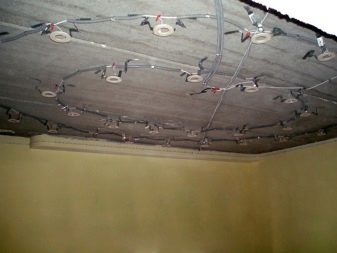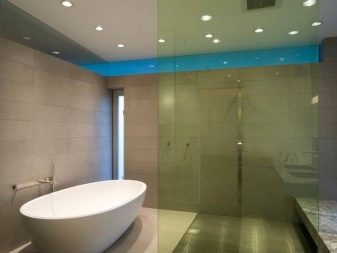Built-in lights for the bathroom
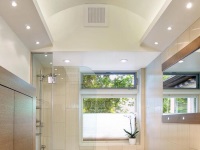
Recessed lighting fixtures can be installed in any room of the house, but their use in the bathroom is the most justified. In this article, we will talk about the advantages and disadvantages of this type of light fixtures, their varieties and peculiarities of installation.
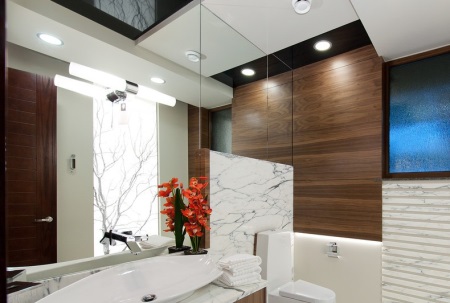
Pros
- Recessed luminaires are mounted in plasterboard or stretch ceilings. Thus, the body of the device is reliably protected from moisture, which is always present in the bathroom.
- Recessed ceiling fixtures are very compact, and this quality is especially valuable in the shortage of space. Due to their small size, you can use several light fixtures in one room, illuminating different areas.
- In the bathroom, it is rare to install a single recessed lighting fixture. Usually either several small spotlights are used in different areas of the room, or one large lamp is used in combination with two or three spotlights. This creates uniform, bright lighting that is difficult to achieve with conventional ceiling or wall light fixtures.
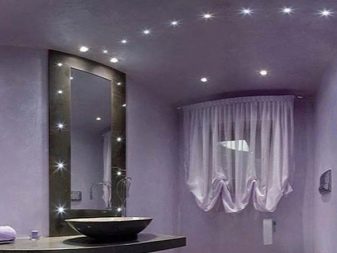
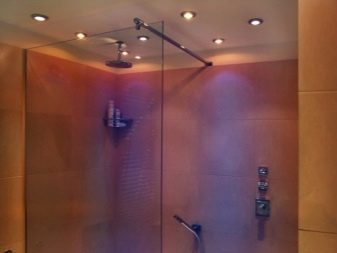
Cons
- Recessed fixtures are more difficult to install than conventional sconces and chandeliers. It's the same with replacing a burned-out light bulb: to replace the light source you will have to almost completely disassemble the light fixture.
- The location of recessed lighting fixtures should be thought about even before the room is fitted with a ceiling. Once the stretch ceiling or plasterboard ceiling is installed in place, it will be impossible to change the location of the lights.
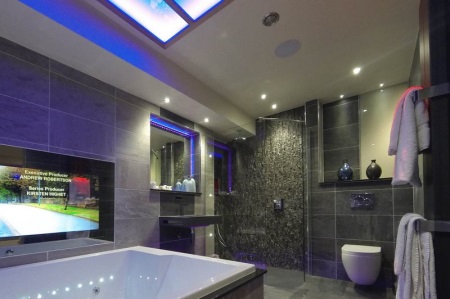
Requirements
- The total brightness of all lighting fixtures in the bathroom must be at least 200 lux. This is necessary for the normal well-being of all members of your family. Therefore, when choosing bathroom fixtures, be sure to pay attention to what brightness of the bulbs they are designed for.
- Electrical equipment in the bathroom should be secured. All metal parts must be grounded. As for the electrical wires, they should only be conducted in a concealed way.
- The bathroom is the "wettest" room in the house, so all the electrical appliances that are located there, in one way or another, come into contact with water. Recessed lights installed in the bathroom must be protected from exposure to humid air, water splashes and steam. Read about which luminaires can be considered moisture-proof in the next section.
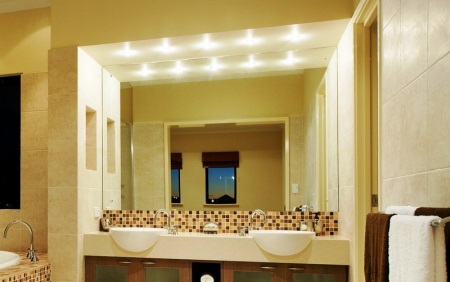
Moisture proof
If the luminaire can be used in conditions of high humidity, its packaging bears the marking IP - Ingress Protection (degree of protection). After the letters there are two digits, the first of which indicates the protection against dust and foreign bodies, and the second one indicates the protection against moisture. The higher these numbers, the greater the protection rating of the recessed luminaire.
If the second digit in the marking is from 0 to 3, then this light fixture cannot be installed in the bathroom. Of course, electric shock from an unprotected lamp is unlikely, but its life span in constant contact with water will be very short. The numbers 7 and 8 mean that the device is able to stay in the water for some time without ceasing to function. Buying such lights for the bathroom would be a waste of money, as they are usually used for lighting swimming pools and other similar places. Thus, the optimal degree of moisture protection for built-in bathroom fixtures is 4.5 or 6.

Placement
The number of recessed ceiling lights is determined, depending on the size of the bathroom.
If the room is small, then one lighting fixture, located in the center, will be enough. If its brightness will not be enough, another such lamp can be installed near the mirror.
For spacious bathrooms, the options for positioning recessed lighting fixtures are much more. Usually designers use different combinations of main and additional lighting. So, the main light can be installed in the center of the ceiling, and the functional areas of the room can be illuminated by recessed lights. You can do without a central chandelier. In this case, recessed lighting fixtures are placed around the perimeter of the bathroom, thereby achieving uniform lighting.
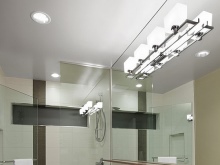

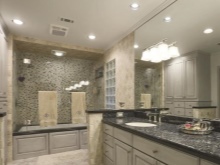
Types
In recessed lighting fixtures can be used light bulbs of different types. Consider the main characteristics of each of them.
LED .
LED, or led-fixtures for the arrangement of apartments have been used relatively recently. This is due to a fairly high cost of light sources. To equip the entire apartment with LED bulbs, will have to spend a lot. Except for its high cost, LED-lights have many advantages.
These include:
- long service life (more than 2000 days of continuous operation);
- low power consumption;
- good brightness at low power;
- large selection of colors of luminescence;
- Possibility to connect a dimmer (dimmer control);
- no heating;
- resistance to mechanical damage.
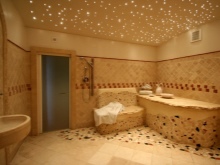
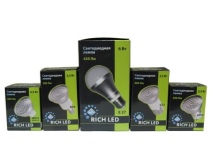
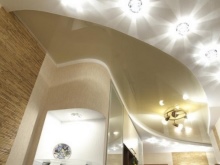
Halogen
Halogen lights are perfectly tolerant of high humidity, give a smooth, bright light and have a long life.
But despite the fact that they have excellent performance characteristics, halogen lamps are not recommended for use in small, unventilated rooms, which includes the bathroom.
If you do decide to install this type of light in your home, take care to equip the bathroom with a powerful ventilation system and equip the wiring with a step-down transformer. It should also be noted that the bright light of halogen lamps experts recognize harmful to vision.
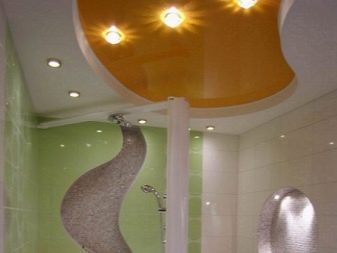
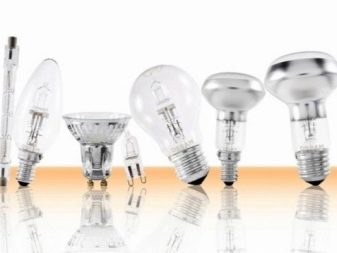
Fluorescent
Fluorescent lamps are similar to LED lamps in their characteristics, but there are a few small differences between them.
- Fluorescent lights give off a very bright light, while LED lights provide softer, more even lighting.
- Fluorescent fixtures are rarely installed in living areas because, even when not in use, they crackle and flicker. For some people this is not a nuisance, but for others it is a significant irritant.
- In contrast to LED lamps, fluorescent lamps can heat up slightly. True, compared to incandescent bulbs, the degree of heating is negligible.
- Fluorescent light bulbs are much cheaper than LED. And this is their definite advantage.
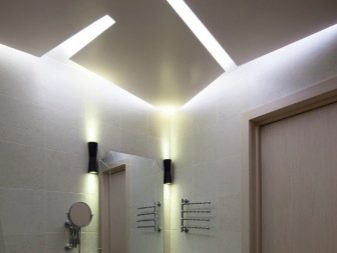
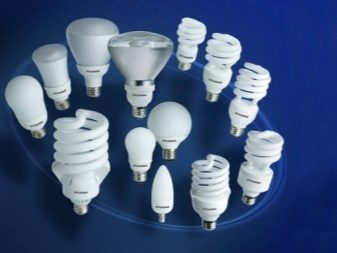
Incandescent bulbs
In recessed luminaires are used very rarely. This is due to their large size, short life span, high heating temperature and other important factors.
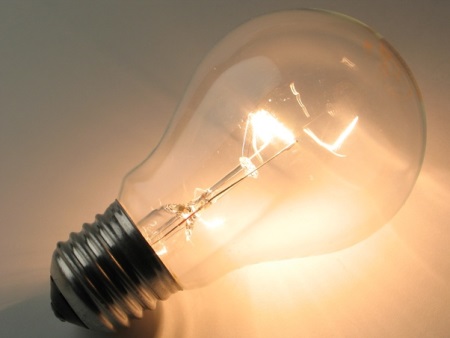
Shapes and sizes
Recessed ceiling fixtures differ not only in technical characteristics and the type of bulbs used. On the market of electrical equipment there is a fairly large selection of bathroom fixtures of different shapes and sizes.
The size of a recessed lighting fixture depends primarily on the number and type of light sources used. The largest lamps are designed for incandescent bulbs: the diameter of the emitter in such models is 8-12 cm. For halogen bulbs are available smaller lights - with a diameter of the emitter from 3 to 6 cm.
The larger the luminaire, the lower the level of the ceiling must be. This should be taken into account when choosing recessed luminaires. A more acceptable option would be to purchase several small fixtures instead of one large one, but, the ceiling in the room would remain high.
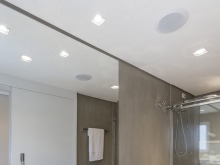
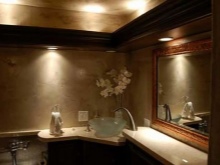
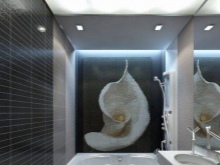
Selection tips
To summarize all of the above, there are a few basic criteria for choosing moisture-resistant light fixtures.
- Be sure to pay attention to the marking indicating the degree of protection of the product from moisture. Consider the location of the luminaire: the closer it will be to the source of water, the higher the IP index should be.
- Another important factor - it is the brightness of the lighting fixture. It must meet the requirements for each particular room. The brightness of the luminaire depends on the power of the bulbs and the degree of transparency of the plafond.
- The number and brightness of fixtures should be determined based on the size of the bathroom. It is necessary to take into account not only the area of the room, but also the height of the ceiling.
- Not the least important role is played by the appearance of the lighting fixture. The design of the recessed lighting fixture must be in harmony with the interior of the bathroom, so when choosing a lamp be sure to take into account the style and color design of the room.
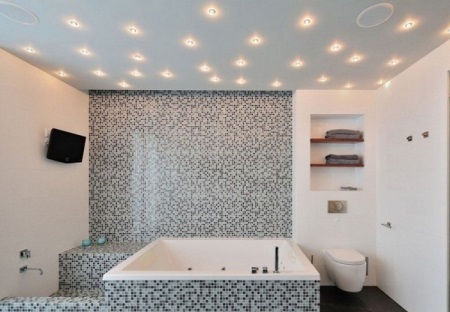
Mounting
Installing a light fixture in a plasterboard ceiling begins with preparatory work, including bringing electrical wires to the place of installation, equipping the wiring with the necessary protection and installation of the framework for the ceiling.
When the plasterboard ceiling with a hole for the lighting fixtures installed in place, you need to connect the lamp to the electrical wiring. To do this, the cable is passed inside the body of the light fixture and screwed to the terminal box.
Now you need to fix the lamp in place. Most models are designed with special "ears", by squeezing them, the light can be pushed into the hole.
To install a recessed lighting fixture in a suspended ceiling, you must first fix a special bracket on the main ceiling that will support the lighting fixture. Once the stretch ceiling is mounted, a cross cut must be made in the place where the light fixture is installed. Then you should connect the light fixture to the electrical wiring and fasten it to the bracket.
